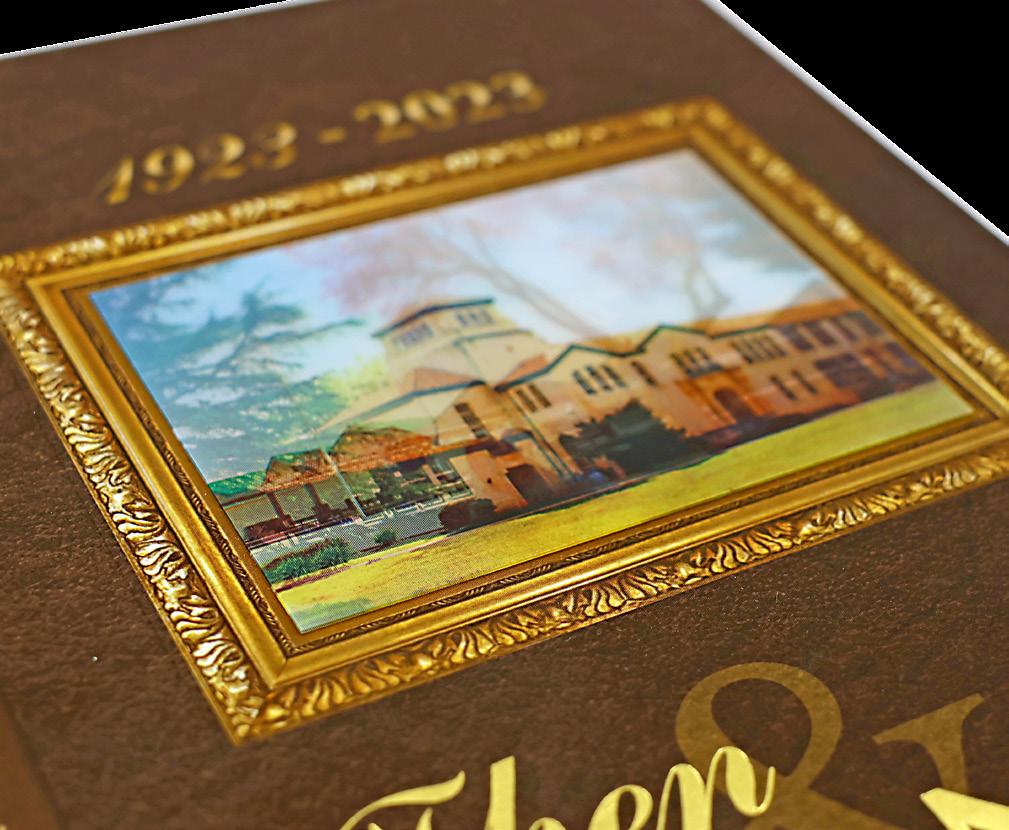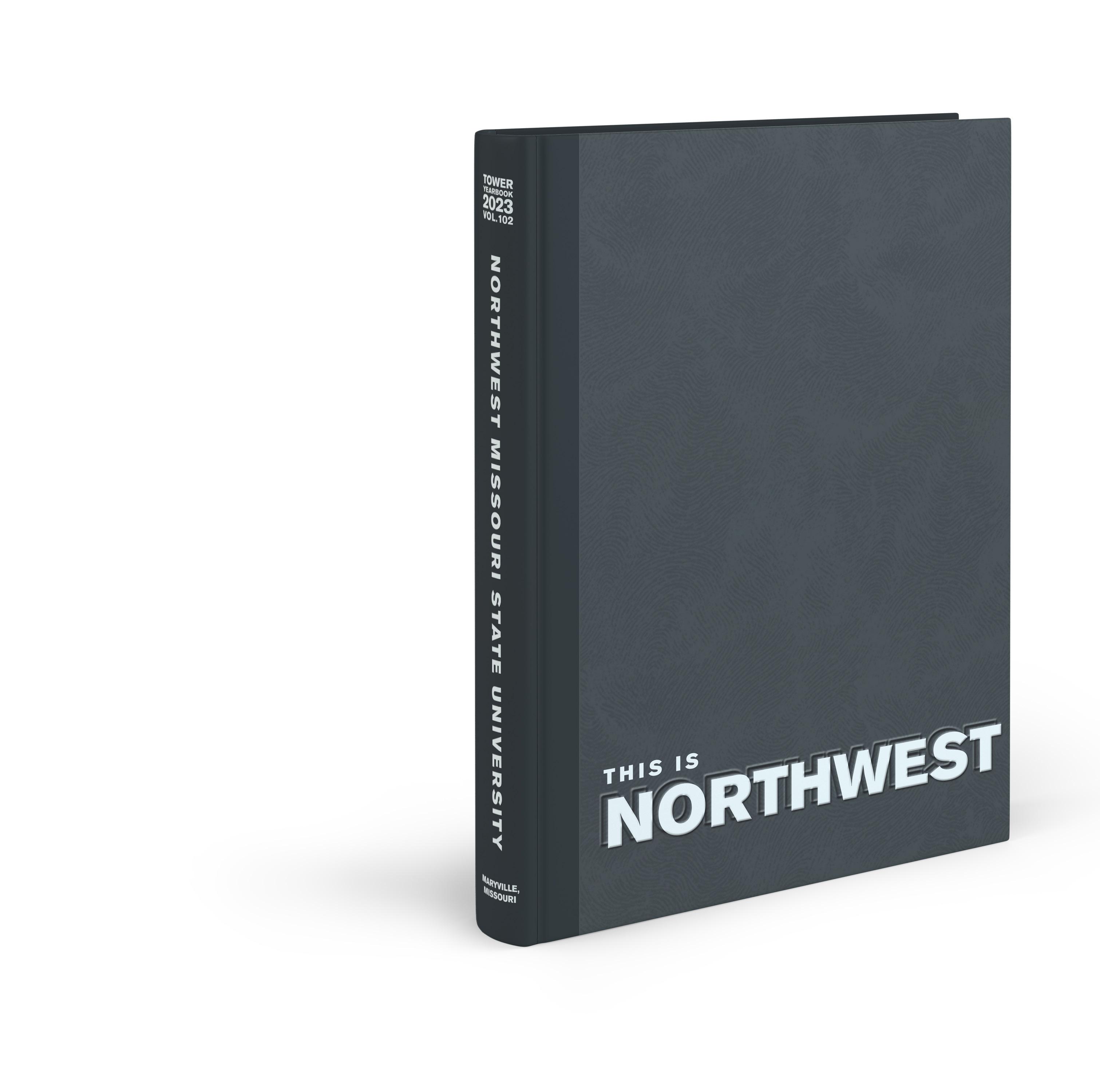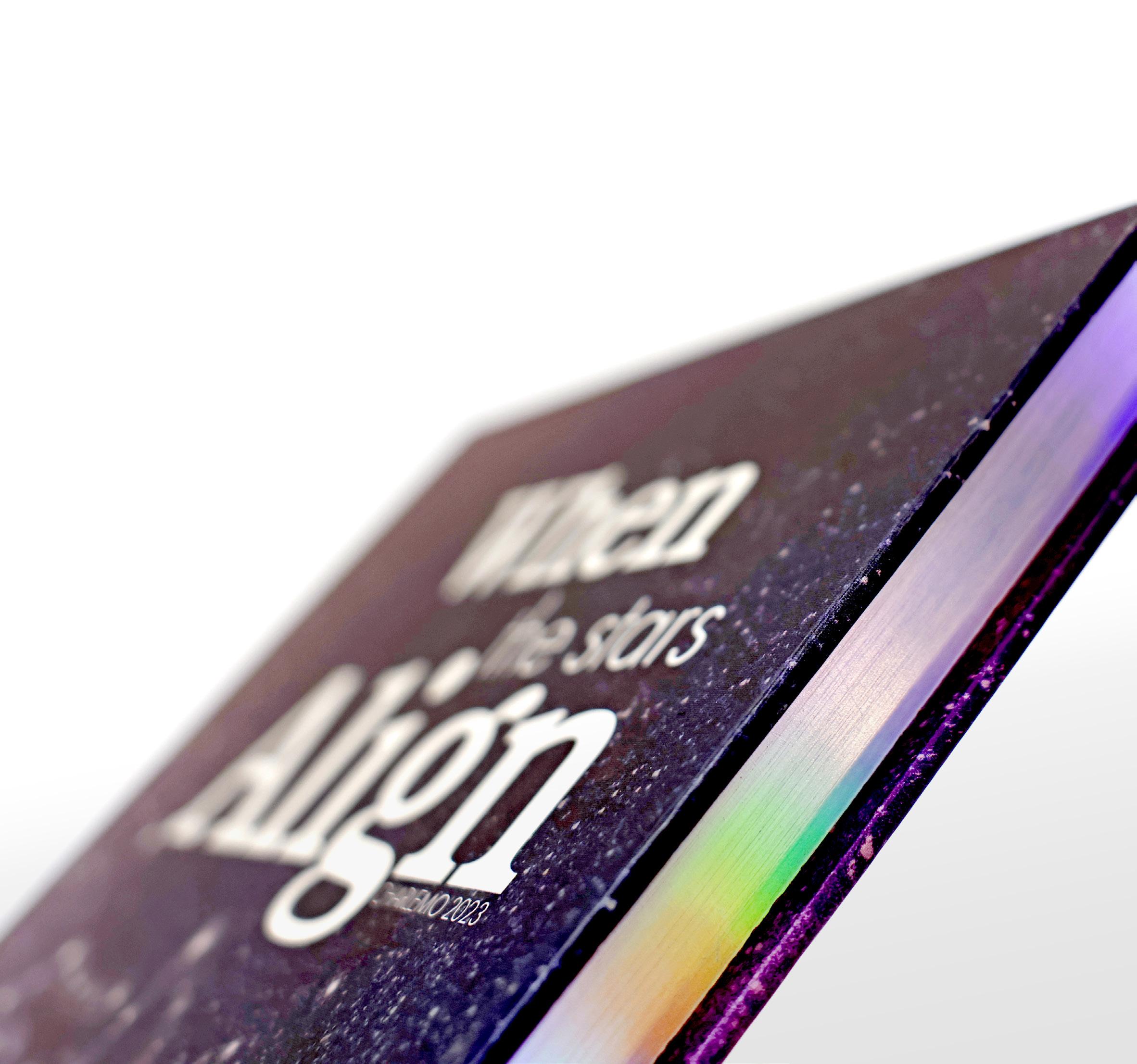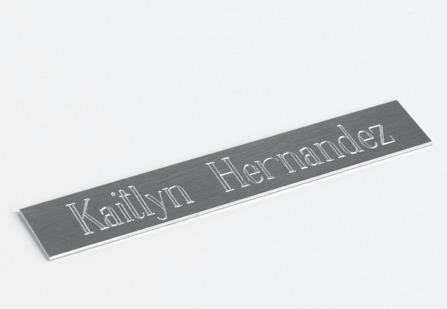WE’VE GOT YOU COVERED.
CUSTOM p. 2–31
BASICS p. 32–36
Learn
CUSTOM COVERS
WHERE TO BEGIN
The first stop in developing a knock-out cover is your rep. With your theme idea and design inspiration in hand, make sure to check your budget before you set your heart on a specific cover upgrade. The next stop is to take a look at these inspirational cover designs and choose the combinations that appeal to you.
1.
COVER ADD-ONS
From laser cuts to debossing to using materials like Mylar or plexiglass, this is the most popular category for getting impressive results.
4 .
COATINGS AND APPLICATIONS
Our listing of coatings, like Gloss UV and glitter UV, has never been longer. Mix two for more pop. Did you know we have photo-sensitive and glow-in-the dark, too?
2.
SPLIT-RUNS
A crowd favorite, especially when it fits the theme, you can print more than one version of your cover or endsheets.
5.
INSIDE THE BOOK
There’s plenty of room for “wow” inside your book, too. Schools love Mylar endsheets, vellum tip-ins and spot Gloss UV on pages. Bling never gets old when you’re celebrating.
3.
FOILS
Foil has been around for a long time, but creative applications mean it never gets old. Especially in small doses, foil is very in vogue.
6.
FINISHING TOUCHES
These little extras can make a stand-out cover that much better. Ever try gilded edges? How about a ribbon bookmark? So much fun!




LASER-CUT
Laser-cutting allows shapes to be cut out of a cover with more precision and detail than using a standard die. In most cases, the laser cuts through the cover after the endsheet is adhered to it. The printing on the facing endsheet is visible through the laser-cut, so careful planning is required to coordinate the cover and the endsheet design. Make sure to allow extra time for production of laser-cut covers. This black Matte cover showcases the bright neon endsheets to match their theme.
Laser-cut cover reveals printed endsheet.

Laser cut registers to show photo on front endsheet with metallic gray ink and Chalkboard UV added to the Suede lamination.


TERRA ENVIRONMENTAL RESEARCH INSTITUTE
Lycanthropos | MIAMI, FL
Q uarterbound cover features Metallic Brushed Sapphire and Permocote materials with custom debossing, Nickel foil, and Wolfgrain overgraining.

already been defined with silkscreen, lithographic ink, metallay or foil. Blind debossing is not decorated,

a cover. These areas can be blind embossed — leaving only the raised elements — or decorated with silkscreen, metallay or foil. Embossing can be used on litho covers to enhance the printed design. Be aware that small or fine details may not reproduce well when embossing.
NORTH HS
CUSTOM

QUARTERBOUND COVERS
Quarterbinding is the division of the front cover into two sections, each with a different base material. This binding process allows for a variety of combinations. A traditional quarterbound cover is made up of two contrasting base materials. Other options include combining a traditional base material with clear plexiglass or another rigid material, like metal or wood. Note: All plexiglass covers will be quarterbound.
PLEXIGLASS
Plexiglass provides an interesting option for the front panel of a quarterbound cover. The transparency of the plexiglass allows staffs to utilize the front endsheet — or even the title page — as part of the design. Plexi can be clear, frosted or color.
Special cover material with custom kiss-cut plexiglass front lid as well as ribbon bookmark. Spine and endsheet feature Silver foil.

Ebb Tide
Quarterbound cover with special-order material as well as a lenticular, Silver foil and ribbon bookmark.

A frosted and etched plexiglass front lid is quarterbound with a suede laminated full-color litho cover.

A plexiglass litho with Raised UV on Matte lamination. The spine also features Red foil.

A quarterbound look is created by adding a grain to the corkboard section of this litho cover, also features a debossed theme statement.

Quarterbound cover with Metallic Brushed Silver material and specialorder Iridescent Marine material.
Metallay is a metallic material, available in silver and gold, that can be applied to an area of a custom embossed cover. This application certainly makes an impression!

Special-material cover features an extra large mascot metallay.



LENTICULAR
This is a multi-step printing process that consists of creating a lenticular image from at least two images, and combining them to show a set of alternating images that appear to transform into each other. The images can be seen independently when viewed at different angles.


TIP-ONS
A tip-on is any physical object added to the outer cover of the book, in this case LEGO® bricks. We’ve seen an increase in lenticulars and chenille letters being added as tip-ons. It’s a great way to make a book stand out.
CUSTOM
METAL AND WOOD COVERS
In addition to plexiglass, schools have chosen quarterbound covers using metal or wood. Both options are sturdy and impressive. Materials will be sourced just for your book and the look you are going for, so planning and careful description of your goals helps with this process. (Not to mention extra time for materials to be ordered!)

MOORE CATHOLIC HS Moore Memories | ORLANDO, FL
Brushed Sapphire base material with embossing, and White and Silver inks quarterbound with an etched aluminum panel.

MOUNTAIN VIEW HS Pinnacle | BEND, OR
Metallic Chrome cover material with Black ink on the spine quarterbound with an etched wood panel.
CHESTATEE ACADEMY GAINESVILLE, GA
Matte

GRAINING
A textured, embossed grain can be applied to a silkscreen or litho cover. The grain can cover the entire cover or it can be applied to draw attention to a particular area of the design. Grains are best for larger areas. Another technique can be used for smaller details.

COVER FLAP
Concept should rule the design. In this case, the staff was going for a leather field journal look to match the theme “Artifact.” When opened, the flap reveals images of artifacts from the school year presented as if they are broken pieces. The opening represents a time capsule of the year, carrying the cover concept into the book.
PADDED COVERS
Padded covers are often used for special-edition volumes or whenever a staff wants to provide a more sophisticated book for their readers. Soft padding makes a book feel substantial, like a leather journal.


MONSIGNOR EDWARD PACE HS
Torch | MIAMI GARDENS, FL
Split cover order: Both share board-level embossing of the theme statement, but differ between Scarlet Glitter Linen base material with Pale Gold silkscreen and Brushed Gold base material with Bright Red silkscreen.


MARK MORRIS HS Almonarch | LONGVIEW, WA
Laser-cut cover with Frost Linen and embossing on back lid.

SPLIT-RUN COVERS
There are many reasons a staff might choose to make different cover designs in the same year. Whether it’s featuring your school colors, in the case of Mark Morris High School, or just giving students a choice, this is a fun and easy way to make your book stand out.
PLAY OFF THE THEME
These schools created different covers for their yearbooks. Notice how the themes lent themselves to the multiple cover designs. “We’ve Totally Got This” allowed the students to “get” the cover they wanted. Well played, middle-schoolers.







NORTHWEST MISSOURI STATE UNIVERSITY
Tower | MARYVILLE MO
Offered in four styles, this litho cover features Caracul graining, embossing and Gloss UV coating.


RIDGE SCHOOL
The Founder | CARLSBAD , CA
Three cover options for this litho cover with Matte lamination.

FOIL STAMPING
Foil is a fine, durable metallic material that can be applied with a die to the surface of a cover.
Foils are available in a variety of solid colors and patterns. Textured dies provide a unique finish for the metallic effect of the foil, as does applying foil to a textured cover material.






CUSTOM DESIGNS
Because each foil application requires a custom die to be made, it is completely customized. You can choose a textured or flat die, or even a multi-layered application. A standard die charge includes an area of no more than 25 square inches.

LAMINATION
Lamination is a clear coating that protects the ink on the printed cover. Lamination protects the outside of the book, where UV coatings may cover only certain spots as determined by the design. All litho covers are automatically gloss laminated unless a different lamination is specified. Three different finishes are available from which to choose. Suede lamination has a velvety texture and no shine, while matte lamination has a dull sheen, and gloss lamination has the shiniest appearance.
THOMAS JEFFERSON
HS FOR SCIENCE AND TECHNOLOGY
Techniques | ALEXANDRIA, VA
and

UV COATINGS
UV coatings are applied wet to a printed sheet and then dried using ultraviolet light. The application not only enhances the printed colors beneath it, it also helps protect the printed cover. There are several different UV coating options available to enhance any yearbook cover design. With this example of Raised UV, the tiny lines that give the type a 3-D look are topped with UV coating for even more dimension.
cover with Raised UV over the type and Suede lamination.
CUSTOM
GLOSS UV
Gloss UV coating can be applied to specific parts of a design to provide a high sheen that makes the elements pop off the page. Using Gloss UV coating on a cover with matte or suede lamination provides a dramatic contrast between the dull finish of the lamination and the shine of the coating.

Gloss UV coating on specific parts of the cover
theme statement make it stand out


ROUGH UV
This application creates a highly textured surface where it’s applied. It almost feels like sand has been mixed into the coating. It’s great for intentionally making design elements look and feel bumpy.

GLITTER UV
Available with gold, silver, green or red flakes, glitter UV coating offers all the benefits of UV coating with an added sparkle. These coatings have the most impact when they are used with matte or suede lamination. Glitter UV can be used as a background or applied to printed design elements for added impact. The glitter UV on this cover helps make the ampersand pop and reinforces the brightness of the spark graphic.
RAISED UV
Like Gloss UV, Raised UV is a highshine, clear coating. However, it is a thicker application that provides a raised texture to the printed surface. Some schools choose to mix Gloss UV and Raised UV to provide different layers on one cover.

CUSTOM


HEAT-SENSITIVE UV
Thermal UV is an application that changes color as it reacts to applied heat. When you touch or rub the coating, an image printed underneath is revealed. Small surface areas are most effective.
Olympian | DAVIE, FL

PHOTOCHROMIC UV
This cover innovation harnesses the power of light to dazzle buyers. Here, a subtle tone-ontone cover blooms into a “bright” type treatment revealing an 18 when exposed to sunlight.


GLOW-IN-THE-DARK UV
This UV coating can be applied to design elements to make them glow a bright green when they are viewed in the dark. They appear a translucent white unless they are in the dark after being exposed to light.

LA COSTA CANYON HS The Stampede CARLSBAD, CA
Black ink, different front and back, on special-order Silver Metallic Poly Mylar® front endsheet and White Vibracolor stock with Silver Glitter UV coating back endsheet.
ENDSHEETS
Typically, endsheets are where staffs provide a table of contents and reinforce the theme message from the cover. They are also an area where you can get creative and add a “wow” moment.

LASER-CUT
Adding a laser-cut to the front endsheet means page one interacts and supports it graphically and thematically. Here, Strawberry Crest’s theme, “On Our Own,” leads the reader to “But Not Alone,” adding another layer to the theme statement.

SHORT-TRIM
The leading edge of the endsheet can be trimmed to add interaction between the endsheets and page one.Alexandria City’s design matched the Gold foil on the endsheet with the design of the title page and created a seamless look for the endsheet by hiding the theme and required text under it.

GLOSS AND GLITTER UV ON INSIDE PAGES
Adding Gloss UV to senior photos or theme elements is a popular practice in the art of making images pop. Katherine L. Albiani MS followed their theme, Extra, and added Silver Glitter UV to the headline packages on opening pages. The extra sparkle made the bright colors really stand out.
PRINTING ON VELLUM
Vellum, a semi-transparent paper, is often added a page or two at a time as a tip-in. Vellum can be printed or foil stamped. In this case, the Patriot staff added senior signatures to two pages of vellum, which open to reveal the senior class photo.
FOIL STAMPING ENDSHEETS
Foil is great for covers, but it works on endsheets, too.
Varsity Yearbook offers a variety of standard and specialty foils.


CUSTOM

FOLD-OUT PAGES
If your staff is looking for a way to highlight a special event, consider a fold-out tip-in. This example from Techniques is a double gatefold, which not only reinforces the theme but highlights the spectacular photography from an International Night performance.

THOMAS JEFFERSON HS FOR SCIENCE AND TECHNOLOGY
Techniques
ALEXANDRIA VA
Full-color eight-page double gatefold on special-order Reich Shine Silver paper and tipped between signatures.

WESTERN HS
| DAVIE, FL
Full-color, four-page accordion-fold tipped between signatures.

MORE TIP-IN STYLES
Whether it’s a multipanel accordion-fold tip-in or a booklet-style tip-in, these additions are a way to include more coverage and content in creative ways. We’ve seen an uptick in schools that have included a literary or art magazine into the yearbook. All of these are great ways to add more memories from the year.
Short-trimmed endsheet as well as shingle-cut tip-in opening.


CUSTOM PART 6:

METAL CORNERS
Metal corners are popular, especially when a staff is going for a traditional or journal look. In this case, the leatherette cover material and gold corners help promote the adventure book concept.

RIBBONS
Ribbon bookmarks come in an array of colors. Notice how the Casady School’s staff used a bookmark graphic on the cover? The three ribbons match the cover and their school colors. The plaid print on the cover reflects the school uniform. So smart.
GILDED EDGES
Gilded edges are added to the book block after it’s completed and before the cover is added. The process can make a book look more traditional, like a treasured novel, or it can add an unexpected rainbow glow to an understated cover, like this example.

Endbands are a tradition in bookbinding used to strengthen the spine. Today, as binding technology has improved, they add a decorative element and are available in several styles. Endbands are called headbands at the top of the spine and tailbands at the bottom. Adding endbands provides an extra polished touch to your yearbook.

COVER BASICS
THE FIRST DECISION
When starting your cover design, and before you get too deep into the process, it’s good to know a few things about the two basic types of covers. The categories are lithography, which we shorten to litho, and silkscreen.
LITHO
The typical litho cover is full-color printing on a white base. The design can include photos, graphics, anything you want. It starts out just like something you’d print on a printer, and then you choose to protect the outer surface with a gloss, matte or suede laminate. And, you can choose other finishing touches like embossing or debossing, foils, etc.
SILKSCREEN
Silkscreen covers use different cover materials in an array of colors. They can have textures stamped into them or can be made of materials that mimic textiles. Over the cover material, you can apply inks, foils, different types of UV coatings and lots of other add-ons. The difference with silkscreen covers is that opaque inks are used. Designs can’t be too detailed and inks can’t overlap.
Once you decide which category of cover your book is going to have, then you can explore all of the options. Your rep or one of our cover artists can help guide you in choosing materials that will work together — not every technique works with every material. They can help take your dream design and make it into a yearbook your whole school will love.


PRINCETON
HS Challenger | CHALLENGER, NC



COVER BASICS
COVER AND SPINE ESSENTIALS
A yearbook cover combines visual and verbal elements to make a great first impression on students who can’t wait to get their hands on their book. The theme should be presented on the cover and then find its way throughout the pages, connecting the concept and events of the year.
Working on the yearbook cover is often one of the first things a staff will do after they have chosen their theme. Making the cover is exciting, as it is the first thing the reader will see when the book arrives. Staffs want a cover that students will love, whether trendy or classic. Make sure your cover is attractive and easy to understand as it presents the theme to the reader. Try to make it different than past covers so it stands out, though many staffs try to feature school colors at least once every four years.
FRONT COVER
Theme
Book name
Year
SPINE
Theme
School name
City and state
Book name
Year
Volume number
BACK COVER
Take it to the next level and consider adding a final bit of theme development with something on the back lid. It could be a spin on the theme statement or just another piece of theme-related artwork.
EXAMPLE
Here is the cover for the 2025 “Yearbooker.” Notice all the pertinent information is included on the book cover and spine. Best practice is to include the book name and theme on the spine, as well.
The theme of this book is “The Best We Can Be.”
If your book has a printable spine, but you’re not able to fit all of these details, try to at least fit the school name and year on the spine.




BASICS
ADD-ONS: FINISHING TOUCHES
PERSONALIZATIONS AND PACKAGES
Building packages for book sales is a great practice. For example, you might build a deluxe package in eBusiness that includes a two-line name plate, a dust jacket and an autograph supplement. Work with your rep to ensure you are pricing these items to benefit your school. It’s an easy fundraiser that makes everyone happy!



NAME STAMP
When you order a name stamp, the student name is stamped on the cover in foil. Adding student names on the cover leaves no question about whose book it is.
ENGRAVED NAME PLATES
Metal plates engraved with student names and icons add a special touch to covers. Not recommended for soft cover books.
PLASTIC JACKET
Hard-cover yearbooks stay protected and clean with these affordable plastic dust jackets.

AUTOGRAPH SUPPLEMENTS
Eight-page autograph supplements include Kleenstick ® tape, so they can be placed into the yearbook once they’re filled with signatures.

WORLD YEARBOOK
Designed for middle/high school readers, this 16-page supplement lets you include a year of sports, science, music and trends in your yearbook — and you don’t have to license photos or do the writing.
OUR WORLD
Intended for elementary schools, add this four-page supplement of activity pages to make your yearbook more fun and interactive. You can also purchase the supplement and sell it separately.
THERE’S SO MUCH MORE
There’s a whole website dedicated to Varsity yearbookers, just like you!
YearbookDiscoveries.com has everything you need to become an expert. Here are a few of our favorite spots online.

Portfolio Online: All of the inspiration you can stand, this is a collection of the best yearbooks we print.


Workshop Sessions: Recorded sessions from our summer workshops live in the Resources section.
For Varsity Customers: You’ll need your login info, and you’ll be amazed by all of the helpful resources here.
